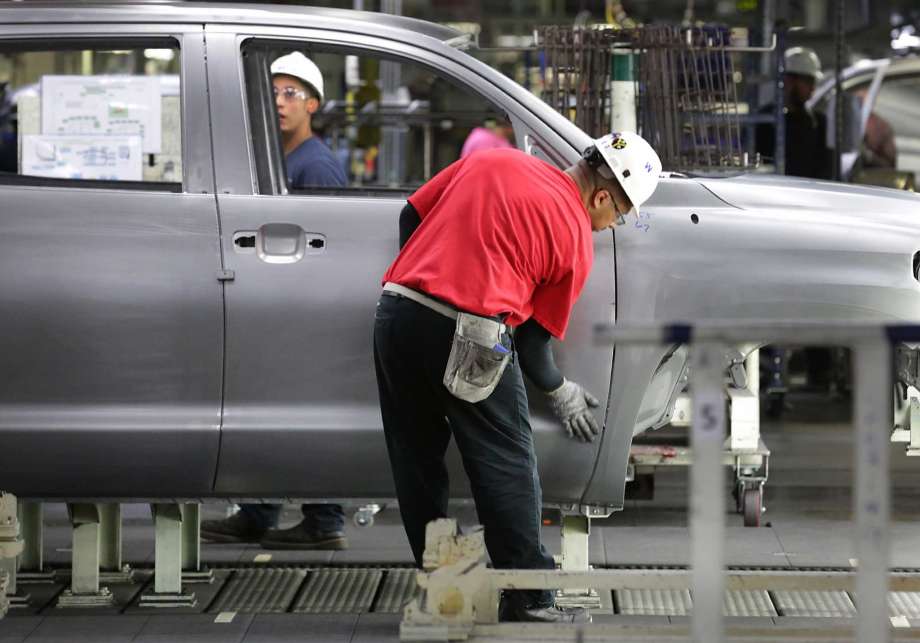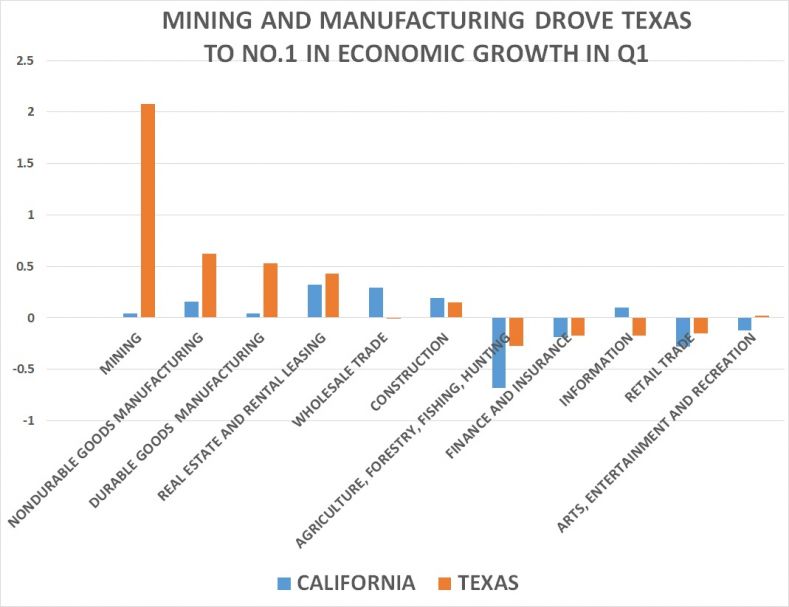(CNSNews.com) – Texas, the nation’s second most populous state, had the fastest growing economy in the nation in the first quarter of this year with its state GDP growing at a real annual rate of 3.9 percent, according to data released today by the Bureau of Economic Analysis.
By contrast, California, the nation’s most populous state, ranked 42nd out of 50 states for first quarter economic growth, with its GDP growing at a real annual rate of just 0.1 percent.
Nebraska had the worst economic performance of any state in the first quarter, with its real GDP declining at an annual rate of 4.0 percent.
West Virginia had the second best economic performance in the first quarter with its GDP growing at an annual rate of 3.0 percent. New Mexico had the third best performance with its GDP growing 2.8 percent.
The Texas economy, according to BEA, was driven up by a boom in the mining sector and by a large increase in manufacturing. California’s economy was dragged down by the arts, entertainment and recreation sector; finance and insurance; retail trade; and agriculture, forestry, fishing and hunting.
California still has by far the largest economy of any state, with its GDP at an annual rate of $2,670,788,000,000 in the first quarter of this year, according to BEA. Texas remained a distant second, with its GDP at $1,682,888,000,000 in the first quarter.
That made California’s GDP $987,900,000,000 (or 58.7 percent) more than Texas’s annual GDP as of the first quarter.
When divided by the Census Bureau’s July 2016 population estimates, California (with a population of 39,250,017) had a per capita GDP of $68,045.52. Texas (with a population of 27,862,596) had a per capita GDP of $60,399.54.
At $1,500,994,000,000, New York ranked third among the states for GDP as of the first quarter.
Florida ranked fourth with a GDP of $955,647,000,000.
The 3.9 percent growth in Texas was largely driven by the mining industry, which contributed 2.08 points to that 3.9 percent growth.
Manufacturing contributed another 1.15 points (including 0.62 for manufacturing of nondurable goods and 0.53 for durable goods); real estate and rental leasing added 0.43 points; administrative and waste management services added 0.32; government added 0.21; construction added 0.15; transportation and warehousing added 0.15; health care and social assistance added 0.14; accommodation and food services added 0.08; education services added 0.06; arts, entertainment and recreation added 0.02; professional, scientific and technical services added 0.01; and other services except government was flat at 0.00.
Like many states in the first quarter, the agriculture, forestry, fishing and hunting sector had a negative impact on the Texas economy—taking 0.27 points away from the state’s growth. Finance and insurance subtracted 0.17 from the Texas economy; information subtracted 0.17; retail trade subtracted 0.15; utilities subtracted 0.10; management of companies and enterprises subtracted 0.03; and wholesale trade subtracted 0.01.
By contrast, California’s meager 0.1 percent growth was led by an 0.32-point contribution from the real estate and rental leasing sector.
California also had positive contributions from wholesale trade (0.29), construction (0.19), nondurable goods manufacturing (0.16), administrative and waste management services (0.12), health care and social assistance (0.12), information (0.10), mining (0.04), durable goods manufacturing (0.04) accommodation and food services (0.04), educational services (0.03), professional, scientific and technical services (0.02) and government (0.02).
Sectors that put a drag on California’s economy included other services except government (-0.01); transportation and warehousing (-0.02); management of companies and enterprises (-0.03), utilities (-0.07); arts, entertainment, and recreation (-0.12); finance and insurance (-0.19); retail trade (-0.28), and agriculture, forestry, fishing and hunting (-0.68).
“Mining grew 21.6 percent nationally,” the BEA said in the press release it put out with the state GDP numbers. “This industry contributed to growth in 48 states. It was the leading contributor to growth in Texas, West Virginia, and New Mexico—the three fastest growing states—which grew 3.9 percent, 3.0 percent, and 2.8 percent, respectively.”
“Durable-goods manufacturing grew 4.4 percent nationally,” said BEA. “This industry contributed to growth in 47 states and the District of Columbia. The largest contributions to growth occurred in Michigan and Kentucky; these states grew 1.5 percent and 1.8 percent, respectively.:
“Agriculture, forestry, fishing, and hunting declined 39.8 percent nationally,” said BEA. “This industry subtracted from growth in 39 states. The largest subtractions occurred in South Dakota, Iowa, and Nebraska, the states with the largest declines in real GDP. Real GDP in these states declined 3.8 percent, 3.2 percent, and 4.0 percent, respectively.”
(First reported by CNS News)http://www.cnsnews.com/news/article/terence-p-jeffrey/texas-booms-39-california-flatlines-01-mining-manufacturing-drive (July 27, 2017)
Want more BFT? Leave us a voicemail on our page or follow us on Twitter @BFT_Podcast and Facebook @BluntForceTruthPodcast. We want to hear from you! There’s no better place to get the #BluntForceTruth.










